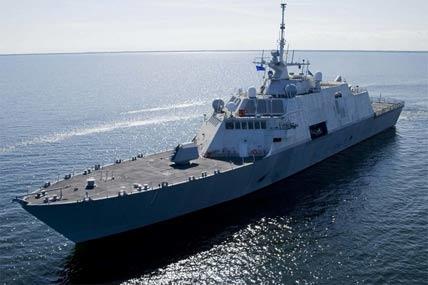The government’s watchdog agency told lawmakers Thursday to rein in the Navy’s ambitious Littoral Combat Ship effort or risk losing congressional control over the service’s race to arm the fleet with an unproven fighting ship.
The Government Accountability Office testified before the House Armed Services Committee after it released a report criticizing the Navy for buying these futuristic fighting ships at a full-rate-production pace without first proving they are capable of the missions the Navy expects them to perform.
“Law and policy says before you go into full rate production, a program has to go through operational testing,” said Paul Francis, managing director of Acquisition and Sourcing Management for the GAO. “I would say that the LCS today is in full-rate production. We authorized four ships a year in 2012, which is the full rate anticipated, yet operational testing is not going to occur until 2019. So in my view, the strategy on LCS has been buy before fly.”
In fiscal years 2014 and 2015, the Navy plans to buy eight more LCS platforms, locking the service into building 24 of the 52 planned LCS ships.
The LCS class consists of two variants. The first of the mono-hulled USS Freedom variants was delivered in September 2008, and the first aluminum trimaran-hulled USS Independence variant was delivered in December 2009. Each of the ships is designed to be fitted with special mission modules for surface warfare, mine countermeasures and anti-submarine warfare depending on the threats at hand.
In the report released July 25, the GAO suggests that Congress consider cutting program money to slow the purchase of LCS ships until the Navy conducts more studies and testing of the seaframes and mission modules.
Navy officials argued against that, telling lawmakers that such a move would only create more problems for the program and the service.
“There is going to be an impact on the fleet because the fleet needs the capability, and this is delaying getting the capability out there,” said Sean Stackley, assistant Secretary of the Navy for Research, Development and Acquisition. “Second, there is an impact associated with the cost of the program. Any delay in any ship-building program is going to have a cost impact.
“We believe that the seaframe production is very stable. To delay the FY 2014 ships, which would be delivered in the 2017-2018 timeframe, to await the completion of later increments of developmental testing, I think that is going in the absolute wrong direction.”
Rep. Jackie Speier, D-Calif., said she was frustrated that Congress has been unable to maintain effective oversight of the fast-moving program, even though the GAO recommended in 2010 that the program move at a slower, more cautious pace.
Navy leaders in 2010 told Congress that “adopting two different seaframes would save money; now we hear the Navy is considering changes to increase commonality between the two variants,” she said.
“I am troubled by the idea that we are purchasing first and testing second. So how do we make sure that this two-year oversight opportunity that we have is actually exercised in a way that we just don’t say at the end of two years: ‘Well too bad we missed the window. We are going to build all these ships, they’re not going to meet the standards, the cost overruns are going to be extraordinary and that is just the way it is.’ ”
Francis told Speier that Congress should demand a detailed report on the proposed design changes. Also, more oversight is needed on the mission modules, he said. Francis explained how each mission module has four increments that have to be tested.
“It will be 2017 and 2019 before all four increments of the mission modules are operationally tested,” he said. “And I would take a really hard look at the 2016 block buy. If that is too many ships or takes you past operational testing, I think you will have yielded a lot of your oversight authority.”
Congress will have to begin preparing to make decisions on fiscal 2016 funding for LCS in the spring of 2015, he said.
Navy officials acknowledged that the program had its share of hurdles in the beginning.
“Clearly, the program had missteps at the front end of the program,” Stackley said. “We have spent time and effort as a department and with Congress to get the program back on the right track. And we believe that is where we are -- we believe that the performance continues to improve.”
Stackley added that the GAO has raised many critical questions; “rather than answer those in short statements, what we owe you and what we commit to you is to come back and present in detail what our plan is and why we believe it makes sense.”





























